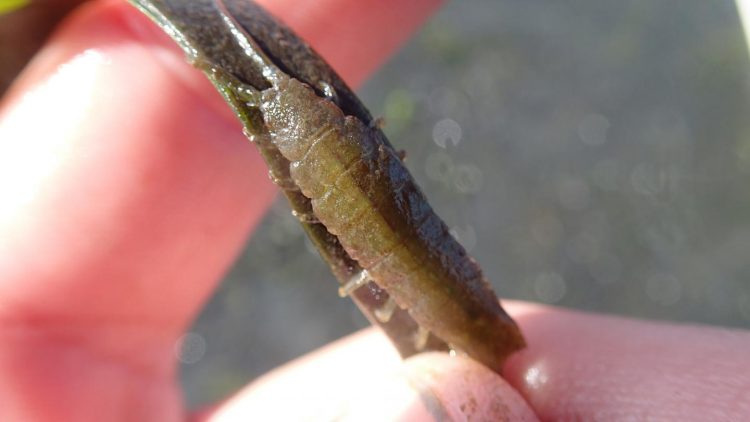Bugs and slugs ideal houseguests for seagrass health

Isopods like this critter found on seagrass at Bodega Bay, California, eat algae and help keep seagrass ecosystems clean and healthy. Credit: Pamela Reynolds/UC Davis
Marine “bugs and slugs” make ideal houseguests for valuable seagrass ecosystems. They gobble up algae that could smother the seagrass, keeping the habitat clean and healthy. That's according to results from an unprecedented experiment spanning the Northern Hemisphere and led by an international team of scientists, including marine biologists from UC Davis.
The study, led by the Virginia Institute of Marine Science, was conducted simultaneously at 15 sites across seven countries through a project called the Zostera Experimental Network, or ZEN, after the seagrass species Zostera marina.
“Our results show that small marine invertebrates are really important,” said Pamela Reynolds, a postdoctoral scholar at UC Davis and VIMS and the ZEN project coordinator. “They graze down seaweeds that might otherwise smother the seagrass. It's a really neat partnership–the animals get a home, and the seagrass stays clean. We found that the more diverse communities of these little algae-eating animals do a better job of keeping the seagrass clean and healthy.”
Reynolds said the results support that comprehensive coastal management should consider how to maintain robust populations of animals in addition to managing for the more conspicuous effects of pollution and disturbance.
SEAGRASSES DECLINING
Seagrass meadows provide valuable fish nurseries and feeding grounds for birds, sea turtles and manatees. They sequester carbon, and their root systems help bind and protect coastlines. Yet, they are declining worldwide due to host of factors.
The researchers explored which of two known threats to seagrass has the greater impact on seagrass ecosystems: pollution from fertilizers or the loss of invertebrate species due, in part, to fishing.
THE IMPORTANCE OF BIODIVERSITY
To simulate nutrient pollution, the team members fertilized the seagrass similarly to how one would a lawn. Then they drove away small crustacean grazers by applying a chemical deterrent, simulating changes in the food web from fishing. On average, removing the grazers produced more algae than adding the fertilizer.
“Our results provide rare large-scale confirmation of the importance of biodiversity to healthy ecosystems,” said Emmett Duffy, the study's lead author and director of the Smithsonian's Tennenbaum Marine Observatories Network. “It's widely understood that controlling algal overgrowth of seagrasses requires reducing fertilizer runoff, but it turns out that maintaining diverse populations of the bugs and slugs that clean these underwater plants is just as important.”
EVERYTHING ZEN
The ZEN project is now in its second generation and has expanded to 25 institutions and more than 50 research sites from the Russian Arctic to Mexico and South Korea. Ongoing work by this collaborative team of more than 200 scientists and students seeks to understand how the diversity of seagrass animals and plants contributes to fish production, carbon storage and other ecosystem services.
“Honestly, its a new way of doing science for many of us,” said Jay Stachowicz, professor of Evolution and Ecology at UC Davis. “Ceding control of our experiments and data collection is hard for many of us who were trained to be fiercely independent. But the payoff is this kind of surprising result that none of us could have obtained on our own and a built-in consensus because we were all involved in each phase of the project.”
The study was published in Ecology Letters and supported by grants from the National Science Foundation and local support from the 15 partner institutions.
The study is available at http://bit.
Media Contact
All latest news from the category: Ecology, The Environment and Conservation
This complex theme deals primarily with interactions between organisms and the environmental factors that impact them, but to a greater extent between individual inanimate environmental factors.
innovations-report offers informative reports and articles on topics such as climate protection, landscape conservation, ecological systems, wildlife and nature parks and ecosystem efficiency and balance.
Newest articles

Silicon Carbide Innovation Alliance to drive industrial-scale semiconductor work
Known for its ability to withstand extreme environments and high voltages, silicon carbide (SiC) is a semiconducting material made up of silicon and carbon atoms arranged into crystals that is…

New SPECT/CT technique shows impressive biomarker identification
…offers increased access for prostate cancer patients. A novel SPECT/CT acquisition method can accurately detect radiopharmaceutical biodistribution in a convenient manner for prostate cancer patients, opening the door for more…

How 3D printers can give robots a soft touch
Soft skin coverings and touch sensors have emerged as a promising feature for robots that are both safer and more intuitive for human interaction, but they are expensive and difficult…





















